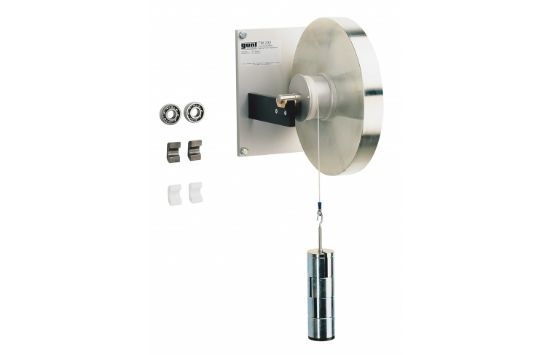Bearings can be classified as slide bearings or roller bearings depending on the nature of their motion. In slide bearings, there is a sliding motion between the bearing and the supported component. In roller bearings, there is both sliding motion and rolling motion between rolling bodies and the supported component. Sliding motion is undesirable in roller bearings, e.g. between rolling body and cage. The bearing force is transferred in the roller bearing by means of rolling.
In both types of bearings—the slide bearing and the roller bearing—frictional forces occur during operation, which oppose resistance to the movement.
The TM 232 experimental unit allows investigations of friction on slide bearings with different bearing shells and on roller bearings. A shaft with a cable drum and flywheel is mounted on a base plate. The weight of the heavy flywheel generates bearing forces. A moment is applied by means of weights, which is equal to the friction moment at the start of the rotation. Replaceable bearing shells are used as slide bearings.
The coefficients of friction are determined in experiments. Bearing shells made of different materials are included in the scope of delivery in order to study different friction pairings. The bearing friction is very low when using the roller bearing. In this case, the flywheel can be used for basic experiments on rotational dynamics.
The experimental unit is designed to be fixed to a wall. The parts of the experiment are clearly laid out and securely housed in a storage system.

Bearing friction
Bearings can be classified as slide bearings or roller bearings depending on the nature of their motion. In slide bearings, there is a sliding motion between the bearing and the supported component. In roller bearings, there is both sliding motion and rolling motion between rolling bodies and the supported component. Sliding motion is undesirable in roller bearings, e.g. between rolling body and cage. The bearing force is transferred in the roller bearing by means of rolling.
In both types of bearings—the slide bearing and the roller bearing—frictional forces occur during operation, which oppose resistance to the movement.
The TM 232 experimental unit allows investigations of friction on slide bearings with different bearing shells and on roller bearings. A shaft with a cable drum and flywheel is mounted on a base plate. The weight of the heavy flywheel generates bearing forces. A moment is applied by means of weights, which is equal to the friction moment at the start of the rotation. Replaceable bearing shells are used as slide bearings.
The coefficients of friction are determined in experiments. Bearing shells made of different materials are included in the scope of delivery in order to study different friction pairings. The bearing friction is very low when using the roller bearing. In this case, the flywheel can be used for basic experiments on rotational dynamics.
The experimental unit is designed to be fixed to a wall. The parts of the experiment are clearly laid out and securely housed in a storage system.
